 Many names of tomato varieties are inspired by the appearance of the grown fruits. The Golden Tiger variety is so named for a reason - its original color really resembles this beautiful animal. But the Golden Tiger is famous not only because of its magnificent appearance.
Many names of tomato varieties are inspired by the appearance of the grown fruits. The Golden Tiger variety is so named for a reason - its original color really resembles this beautiful animal. But the Golden Tiger is famous not only because of its magnificent appearance.
He has qualities that every self-respecting gardener will appreciate.
Content
Grade description
The Golden Tiger (the original name Golden Tiger) is considered exotic for Russians. The appearance of this tomato is striking: medium-sized yellow tomatoes are covered with dark stripes resembling a tiger color. Unusual coloring of tomatoes gives the pigment anthocyanin, the one that is present blueberries, black currants, blackberries.
This variety arrived in Russia from the United States of America. American scientists brought it back in 2013. Golden tiger belongs to rare varieties.
Grade characteristics
Golden Tiger - indeterminate variety. Tomato bush grows gigantic - up to 170 centimeters in height. Due to the thick, juicy green foliage, the plant can hardly be called tomato. However, when clusters of striped tomatoes appear on it, everything falls into place. Each brush (which can be up to 12 and one bush) generates up to 25 medium-sized tomatoes.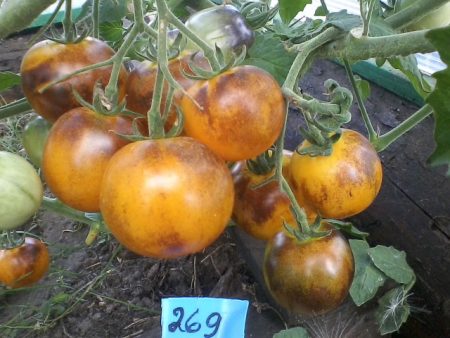
Fruits are characterized by unprecedented external beauty and excellent taste. Tomatoes are round, medium in size, on average 70-120 grams, have a strong tart tomato flavor. The pulp is dense, the tomatoes taste sweet, without acid.
The peel, as befits all tall varieties, is smooth, shiny, dark-bluish at the stalk. During the ripening period of the green color, streaked with longitudinal dark blue stripes. At the stage of biological maturity, the color of the fruit changes to bright yellow, and the stripes are transformed blue-black veins. Since the crust is very thick, this grade is recommended for canning.
The golden tiger has a medium-late fruit ripening period. Harvest usually begin from the beginning of August until the frosts.
The variety is particularly undemanding in maintenance, can develop easily and give excellent results, growing both in a greenhouse and in open ground.
Grade advantages:
- excellent appearance of fruits;
- good keeping quality;
- long fruiting period;
- steel immunity to all known diseases;
- brushes are formed along the entire trunk of the plant, so their number, and, accordingly, the number of fruits is much greater than that of low-growing varieties;
- excellent yield - from one square meter to 10 kilograms of fruit;
- takes up little space on the site, as it grows mainly up.
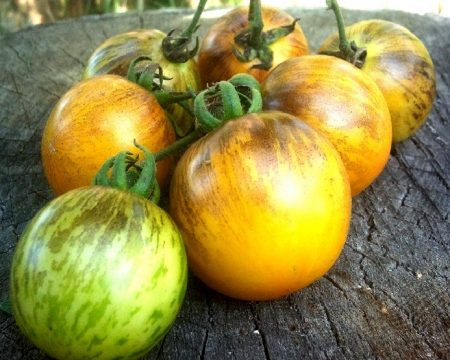
Cons of the variety:
- long growing season;
- collected seeds for the next year will not give the quality that purchased, so it is better to always buy seed material;
- it is necessary to constantly tie up plants, stepchild and form bushes.
Growing Features
Tall Tiger Tomato is grown in the same way as the other varieties. Initially, you need to properly select and sow seeds for seedlings.
Sowing
Sowing seeds is usually carried out 70-80 days before planting on an open bed. Typically, the timing is the end of February or the first of March.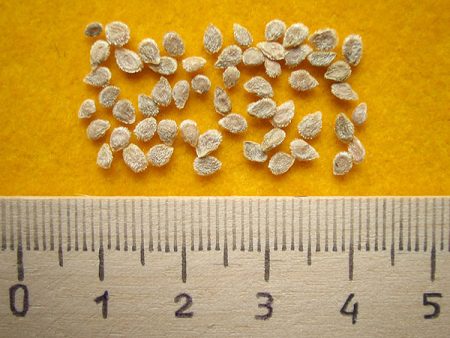
You can buy ready-made seeds, which have already been treated with growth stimulants and disinfectants. If you want to plant your seeds, then they are selected from among the most beautiful and high-quality fruits from the most fruitful brush. Collect seeds from overripe tomatoes.
In the spring, before planting, the seeds must be soaked in a solution of Agricola Vegeta, Effekton, wood ash or nitrophoska (you need to use one). You can disinfect the seed by soaking them with a manganese solution. After processing, the seeds are thoroughly rinsed in clean warm water and dried.
The soil mixture for seedlings should consist of peat, humus and earth in equal parts. Minerals are also added to the soil: on one bucket of soil per teaspoon of superphosphate, urea and potassium chloride. It is recommended to warm the entire mixture in the oven so that the minerals begin to work, and the earth is more saturated with vitamins. The soil before sowing should be slightly moistened so that the seeds “hatch” faster.
Tomatoes are sown in large drawers or cassettes. The soil for seedlings should consist of peat, humus and earth in equal parts. Mineral fertilizers are also added: a teaspoon of superphosphate, potassium sulfate and urea to a bucket of the mixture. The soil should be warm, light, moist.
Seeds are planted in grooves, deepening by one centimeter. The distance between the seeds - 2 centimeters, between the furrows - 5. Top seeds sprinkled with earth and leveled, without compaction. Boxes put on a sunny place in a room with a temperature of 23-25 degrees. For an optimal microclimate, the boxes are covered with foil. The field the appearance of the first shoots the film is removed.
Soil preparation
Tomatoes have been preparing the ground since autumn. Mandatory deep digging with the addition of semi-overripe manure to the soil. Before digging, it is necessary to thoroughly clean the area from its predecessors. By the way, it is better to plant tomatoes in places where cabbage and cucumbers previously grew.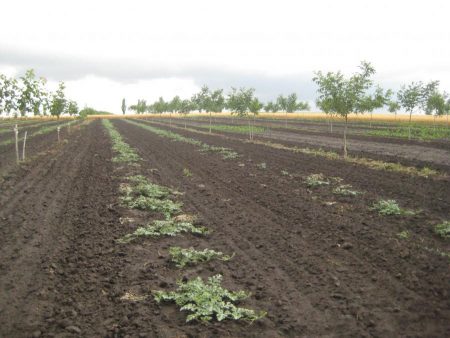
In spring, organic matter, ash, as well as a portion of minerals - potassium chloride and superphosphate are also added.
Landing
Seedlings are planted in open ground on day 65 (mid-May) after sowing, when an average of 8-10 leaves are formed on the plants. The first fruits will appear in a month. And the active phase of fruiting will come after a couple of weeks.
Before transplanting, seedlings are sprayed with prophylactic purposes with copper chloride.
For each bush make a separate hole, a depth of 15 centimeters. It is better to plant tomatoes in a checkerboard pattern, 30 centimeters apart, so they will receive more light and air.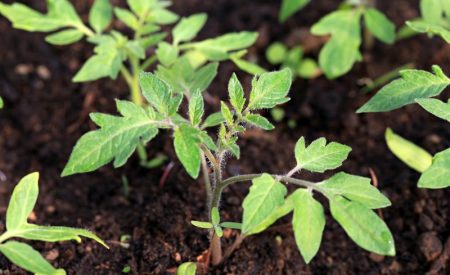
Top dressing
For better growth of tomato bushes, fertilizers should be regularly applied. Theoretically, you need to make fertilizing three times a season, however, if the soil before planting seedlings was well fertilized, you can get by with two feeds.
The first top dressing is introduced two weeks after transplanting seedlings on the bed. You can fertilize tomatoes with organics, for example, to make root dressing with bird manure. Or use special preparations, such as Gumisol, Vermistil, Rost-concentrate.
The time of the second feeding comes with the beginning of the formation of flower ovaries and the opening of the second brush. Copper sulfate and manganese solution are added.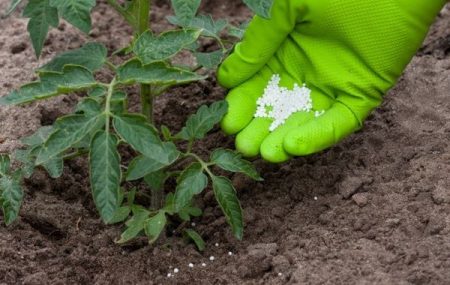
Finally, the third time fertilizer is applied during the formation of the fruit. This time it is better to make mineral fertilizers, in particular, potassium is needed, which contributes to the pouring of fruits.
Care
For a variety of Golden Tiger, you need a kind of care. Bushes must be formed so that there are more ovaries. Plants are usually formed in 2 stems.
Better variety grows in the greenhouse - it is a fact. Therefore, it is advisable to grow the Golden Tiger in greenhouse conditions. So you can get better fruits and higher yields.
Care for the variety is to:
- top dressing;
- watering;
- airing and sunbathing;
- pinching and bush formation.
Tomato is a heat-loving plant, so it is so important to provide bushes with plenty of sunlight and heat. Tomatoes are planted in open areas protected from the wind. It is better to arrange beds from east to west - so they will be lit evenly. It’s important even when planting seedlings to correctly place the bushes, away from each other, so they will receive more food and their portion of light.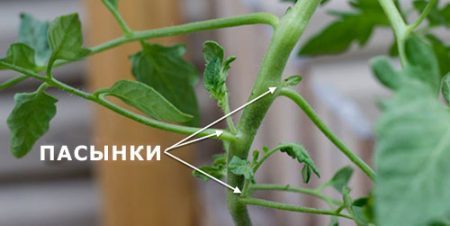
If tomatoes grow in a greenhouse, it is important to ventilate them regularly. In stale humidified air, fungus and late blight are very common. To prevent this, fresh air must constantly flow into the greenhouse. For better ventilation at the roots of plants, it is necessary to break off the lower leaves.
Tomatoes cannot live in arid conditions. The root system should receive a lot of moisture, since the load on it is large: firstly, the bushes grow very large, and secondly, each brush forms fruits, which also take energy. Therefore, the whole crop depends on how much food and air the roots receive.
If tomatoes grow in open ground, then water should be watered as the earth dries. In clear sultry weather, tomatoes are usually watered every two to three days. Plants are watered under the root, 4 liters per bush. So that an earth crust does not form, it is necessary to loosen the soil after watering. Soft and drained soil delivers water to the rhizome faster and also allows air to pass through well. Loosening is best done superficially, since the roots of the tomato are not planted deep and can be easily damaged.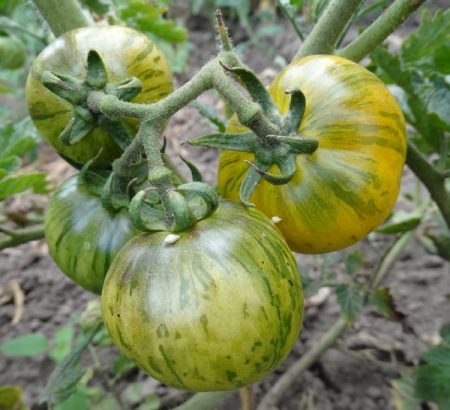
In hot climates, mulching helps to prevent drying out of the soil, as well as retaining moisture in the ground. The ground under the bushes is covered with a thick layer of sawdust or leaves.
Since the bushes of the Golden Tiger sometimes grow under two meters, they need reliable support and tying. You can tie each bush separately or build a single support system. You need to try to tie the bush in time, otherwise it will break off under the weight of the fruit, and you can lose part of the crop.
All tall varieties require the correct formation of bushes. The golden tiger is usually formed in two or three stems. To do this, remove side branches and stepsons, leaving only the central trunk. Lateral shoots (stepsons) take on a lot of nutrients at the expense of the development of the main stem and, accordingly, the fruits. In addition, extra branches only burden the plant and prevent it from growing normally, getting more light and moisture. In addition, dense plants cannot circulate well and therefore often get sick.
The fact that the plant does not develop correctly can be suggested by the large flowers that appear on the first leaves. Ugly fruits usually grow in place of these flowers. Therefore, the flowers must be removed so that they do not inhibit the growth of the plant.
The Golden Tiger, like many modern extraordinary varieties, is able to withstand all kinds of tomato diseases. Even late blight - the most common disease for this culture - does not touch the lanky Tiger, because due to the growth of the plant up, the leaves and stems do not touch wet soil, and during irrigation water also does not get on them.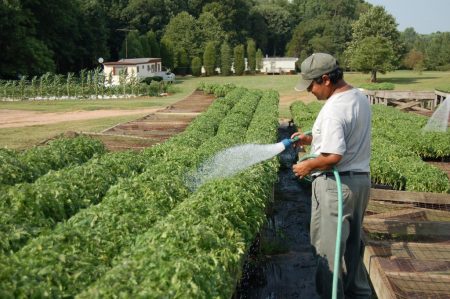
As a preventative measure against fungal infections, tomatoes can be treated with preparations containing copper or sulfur.
Since tomatoes are a self-pollinating plant, they can be helped in this matter. To do this, you sometimes need to shake the brushes on which the flowers grow.
If you follow all the rules, which are inherently not so complicated, the first crop can be harvested already in late July. The variety differs in that it bears fruit for a long time and abundantly. Tomatoes will form and ripen right up to the frost, until the cold kills the plants. Therefore, you need to take care of the unripe fruits in advance: you can remove tomatoes even in their technical maturity. They will quickly reach a sunny, warm place, preserving both their excellent taste and excellent view.
Reviews
Alexandra
In our area, a golden tiger is very rarely raised. Basically, this variety is not even known to gardeners. And I happened to find out and am very happy about this. This variety is late ripe, so there is an opportunity to feast on excellent tomatoes until late autumn. The fruits are sweet, yellow, but the appearance of anthocyanin begins from the stalk. We always collect an excellent harvest, however, there are varieties from which you can pick up more fruits. But it is impossible to tear yourself away from these tomatoes - they are very beautiful, indeed, like a tiger color.
Vladimir
I love tall varieties, although I need to mess with them more. The golden tiger attracted, firstly, the appearance of the fruit. Yellow tomatoes with longitudinal dark blue stripes. Such an interesting combination makes the garden colorful. Secondly, the variety begins to bear fruit in August, just in time for the moment when we begin to make pickles. We do not conserve them often, mostly we eat it. The variety is distinguished by good keeping quality, tomatoes can be stored for weeks, nothing happens to them. In general, a decent grade!
Yulia
They planted this variety somehow. Yes, good, but nothing more to add. Bushes grew a little more than a meter high. Raised them in a greenhouse. The population is small, so there are no problems with the formation of the bush. Fruits are medium in size, approximately 110-120 grams. On each brush 3-4 tomatoes grow. Tomatoes themselves are very sweet, juicy, they feel good in salads. The aroma is so fresh, vegetable. Harvested until the very frost. I was glad that the bushes did not hurt anything serious, so I think the variety deserves attention.




 Low-growing tomatoes, without pinching: 5 of the most delicious varieties
Low-growing tomatoes, without pinching: 5 of the most delicious varieties Why tomato seedlings grow poorly
Why tomato seedlings grow poorly We grow a tomato in a shell
We grow a tomato in a shell Growing tomatoes without watering according to the method of Kazarin
Growing tomatoes without watering according to the method of Kazarin